Gluten-Free Sourdough Bread
Updated
The idea of making gluten-free sourdough bread from scratch seemed so intimidating to me at first. But with the right ingredients, technique, and tips, making my own loaf from scratch was much easier than I thought. Don’t forget to use my gluten-free sourdough starter recipe so you will be ready to go! I love it for breakfast with jam, as a bread bowl with spinach dip, or in any way you enjoy bread.
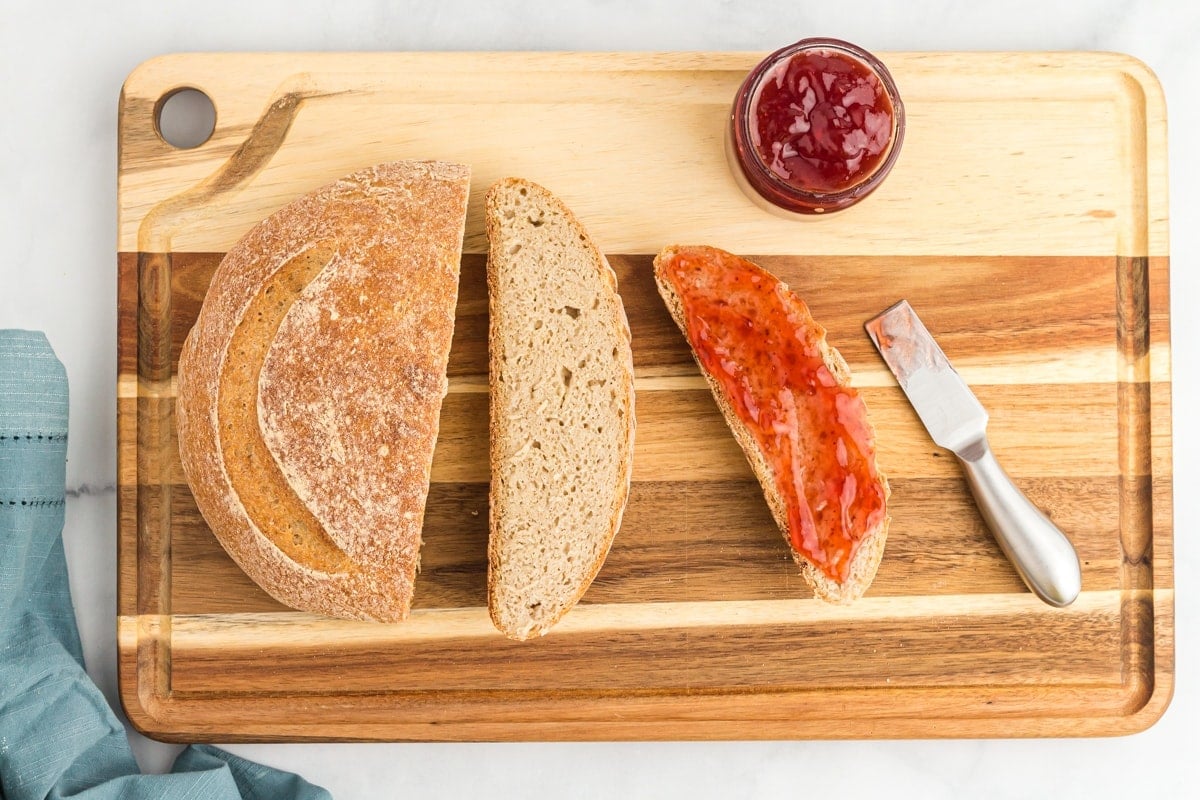
I am brand new at making sourdough bread much less gluten-free sourdough bread.
– Berdjette
From my very first loaf, it turned out fantastic. Loaf after loaf it continues to be excellent. So grateful I found this recipe.
Every person who taste it raves about it, and in my opinion, it has no trace of tasting like gluten-free. As gluten-free people we had pretty much given up on ever eating any good bread again. This has changed everything.
Patience Makes Perfect
This gluten-free sourdough bread recipe is straightforward and simple, but requires some time and patience. When it comes to sourdough baking, many factors determine how your bread is going to turn out—weather, humidity, temperature, flour brands—but the more you make it, the more you’ll start to understand and adjust. So even if your first loaf doesn’t turn out perfectly, take the lessons you’ve learned and apply them to your next loaf.
This post includes step-by-step instructions and photos to help take the guesswork out of making gluten-free sourdough bread. Although there are just a few steps, each one is very important in the process. Read this post in full before you get started so you know what ingredients and supplies you’ll need and how to plan out your timeline for mixing, proofing, and baking.
Necessary Supplies
- Food Scale: Making sourdough bread is a science, and a food scale is a must to help measure ingredients precisely.
- Glass Mixing Bowls: Glass bowls of various sizes are needed for combining different ingredients throughout the mixing and proofing processes.
- Wooden Spoon: For mixing the ingredients together.
- Silicone Spatula: Use the spatula to transfer ingredients from one bowl to another and to combine them. Remember, quantities matter here, so make sure you’re scraping every last bit out of each bowl.
- Electric Mixer with Dough Hook: You can use your hands for mixing the dough together, but it can get quite messy. I recommend an electric mixer with a dough hook to do the majority of the mixing, then just get in with your hands at the end when it needs a little extra kneading to bring it all together.
- Clean Tea Towel or Food-Safe Plastic Wrap: When choosing a tea towel to line your bowl and cover the dough during the proofing process, be sure to find one that’s free of inks, colors, and lint. If you don’t have tea towels, food-safe plastic wrap will work. Just remember to place it on gently to allow airflow.
- Large Bowl with Round Bottom: When proofing your dough, it’s going to start taking on the shape of the bowl, so it’s important to select one with a round bottom.
- Dutch Oven with Lid: A Dutch oven is going to help keep the bread at a high, even temperature during the baking process. Make sure you choose one that’s around 5 quarts in size and can withstand heat up to 450°F. Watch out for plastic handles that aren’t designed to be oven-safe.
- Parchment Paper: Used to create a sling to gently lower the dough into the Dutch oven. Dropping the bread in will limit the bread’s ability to rise.
- Sharp Knife or Lame: You’ll use this to create cuts in the bread that allow steam to escape. If you don’t cut lines in the bread, the bread will split and make its own lines.
- Food Thermometer: This isn’t a requirement, but it does help to take the guesswork out of determining when the bread is fully baked.
Gluten-Free Sourdough Bread
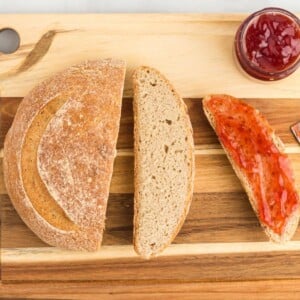
Ingredients
Preferment:
- 150 grams gluten-free sourdough starter, active and at peak rise
- 100 grams room temperature filtered water
- 80 grams brown rice flour
Remaining Bread Ingredients:
- 20 grams psyllium husk, not psyllium husk powder. I recommend the brands “Now” or “Anthony’s”
- 20 grams honey
- 300 grams room temperature filtered water
- 80 grams potato starch, Substitute arrowroot powder, cornstarch, or tapioca starch
- 80 grams sorghum flour
- 80 grams brown rice flour
- 60 grams tapioca flour
- 15 grams salt
Instructions
- Make the preferment. In a medium bowl, stir together 150 grams active starter, water, and brown rice flour. Stir until well mixed. Cover lightly and let rest in a warm, draft-free area of your house for 6 to 18 hours. You’ll know it’s ready when it looks like it’s doubled in size and has lots of bubbles. Do not move onto the next step until your preferment is ready.
- In a medium bowl, stir together the psyllium husk, honey, and water. Set aside for a few minutes until it turns into a thick gel.
- In a large bowl, combine the potato starch, sorghum flour, brown rice flour, tapioca flour, and salt. Whisk together until well combined.
- Add the preferment mixture and the psyllium husk mixture to the dry ingredients and mix on low-medium speed with an electric mixer and dough hook. Use a spatula to scrape down the sides and bottom of the bowl to make sure all the dry ingredients are well combined.You can use your clean hands to work this mixture as well so that all the dry ingredients have been incorporated into the dough (the dough should feel gummy now and you should no longer see dry ingredients).
- Lightly flour (using brown rice flour) a clean, dry countertop and lightly knead the dough into a smooth ball. No stretching of the dough is needed. Simply knead the ingredients together gently until smooth. Don’t overwork the dough.
- Lightly flour a round, tea towel-lined bowl and place the dough ball smooth side down into the bowl so the seam is facing up.
- Lightly cover the bowl with a clean tea towel or food-safe plastic wrap and let the dough proof at room temperature for 3 to 4 hours. Depending on the temperature in your home, this could take longer, up to 6 to 8 hours. It’s ready once it has a soft, puffy texture and the dough rises back up slowly when you gently make an indent.
- An hour before your bread is ready to bake, preheat your oven to 425°F (218°C) with the Dutch oven inside.
- When your oven has been preheating for an hour, gently remove your proofed bread and place on a sheet of parchment paper. Gently move this so you don’t drop it down. Dropping it will limit the bread’s ability to rise properly. The loaf should now be sitting on the parchment paper smooth side up, seams down on the parchment paper.
- Use a sharp knife or a lame to cut lines into the dough to allow steam to escape while baking. Make any design you’d like, but make sure it’s deep enough (at least ¼ inch) or the bread will split in other areas.
- Use the parchment paper as a sling and place both the paper and bread gently inside the hot Dutch oven. Place the lid on and put the Dutch oven back into the oven. It’s important that you don’t leave the Dutch oven sitting out for long. We want this to say as hot as possible so as soon as you remove it from the oven, place the bread in and get the Dutch oven right back into the oven.
- Bake for 45 minutes with the lid on. Remove the lid then bake for an additional 25 to 40 minutes. The bread is done when it is golden brown and the internal temperature is 210°F (99°C). Underbaking will result in a gummy bread.
- Remove the baked bread from the Dutch oven and let it cool completely at room temperature before slicing.
Notes
-
- You don’t want the Dutch oven to be too far down in the oven. If the loaf is starting to burn on the bottom, place a baking tray on the rack under the Dutch Oven to try to block a bit of that direct heat.
- If you want to prepare everything ahead of time, once your dough gets to the proofing stage, you can cover it and place it in the fridge overnight.
- Let the bread cool completely before slicing. If you cut into it too early, you’ll release the steam, and the bread will turn out dense and gummy.
- Mama says, “Make sure to always check your labels!”
Nutrition
Nutrition information is automatically calculated, so should only be used as an approximation.
How To Make Gluten-Free Sourdough Bread Step by Step
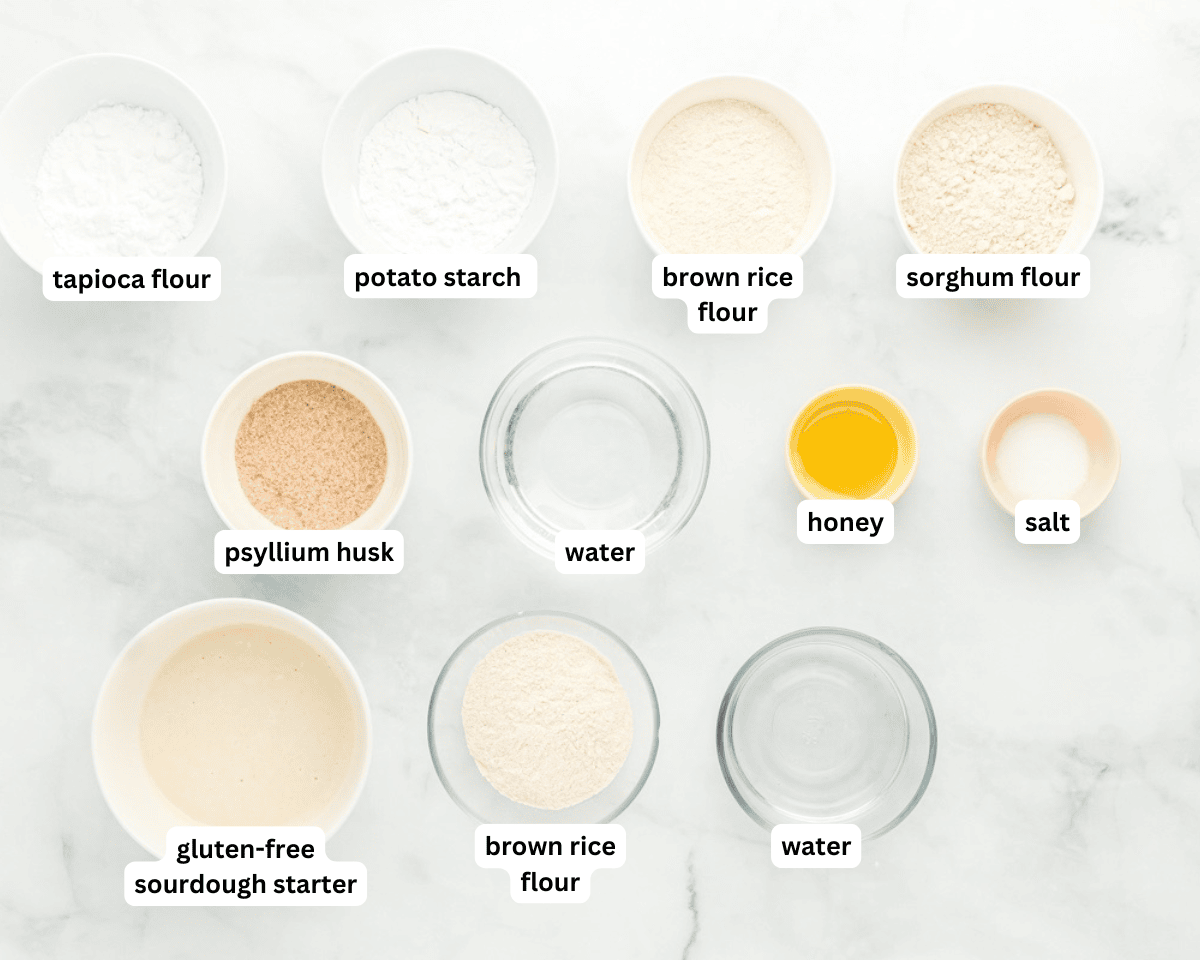
Gather the ingredients: Gather all the ingredients together.
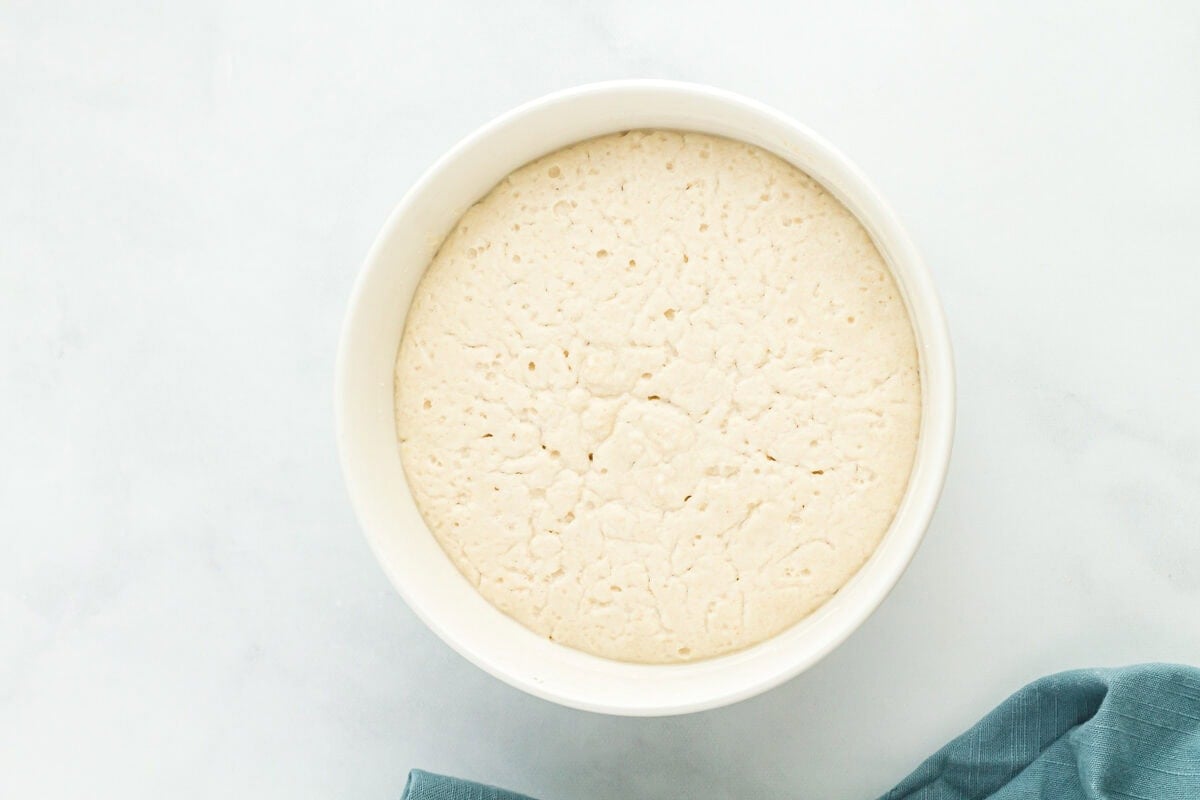
Make the preferment: In a medium bowl, stir together 150 grams of active starter, 100 grams of room temperature filtered water, and 80 grams of brown rice flour. Stir until well mixed. Cover lightly and let rest in a warm, draft-free area of your house for 6 to 18 hours. You’ll know it’s ready when it looks like it’s doubled in size and has lots of bubbles. Do not move on to the next step until your preference is ready.
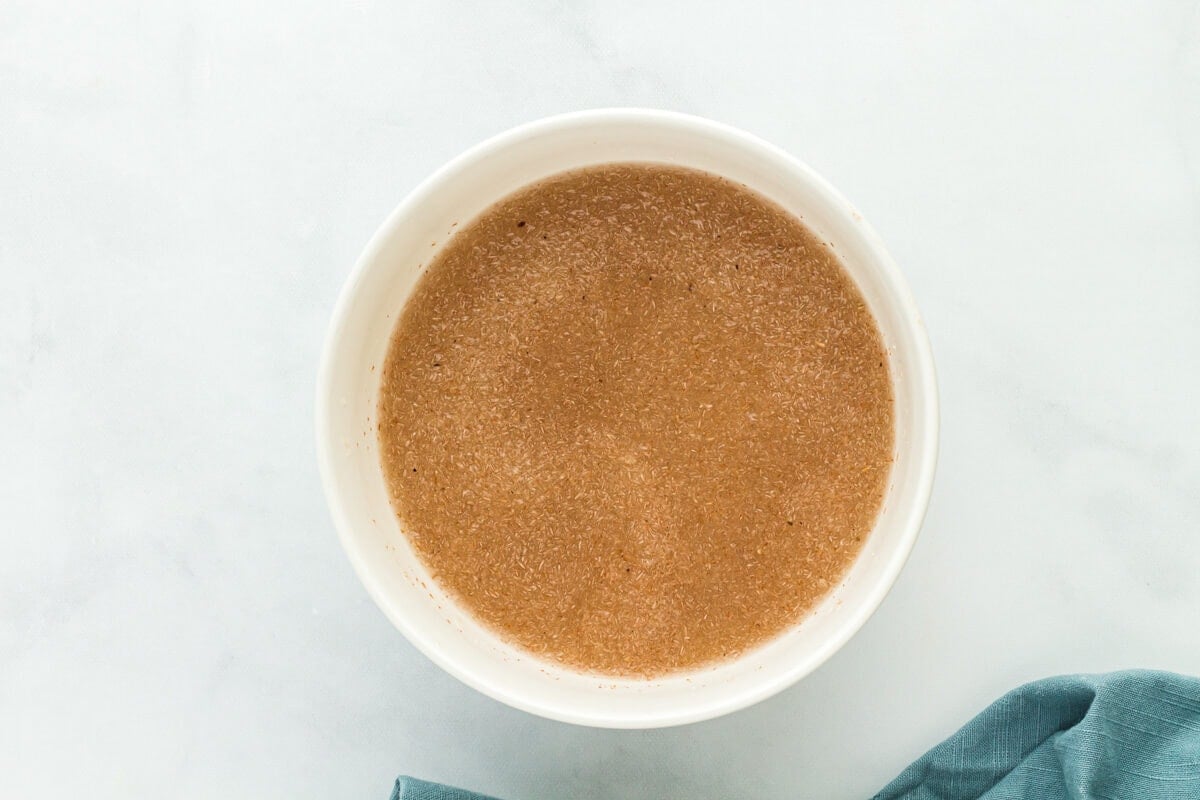
Prepare the psyllium gel: In a medium bowl, stir together the 20 grams of psyllium husk, 20 grams of honey, and 300 grams of room-temperature filtered water. Set aside for a few minutes until it turns into a thick gel.
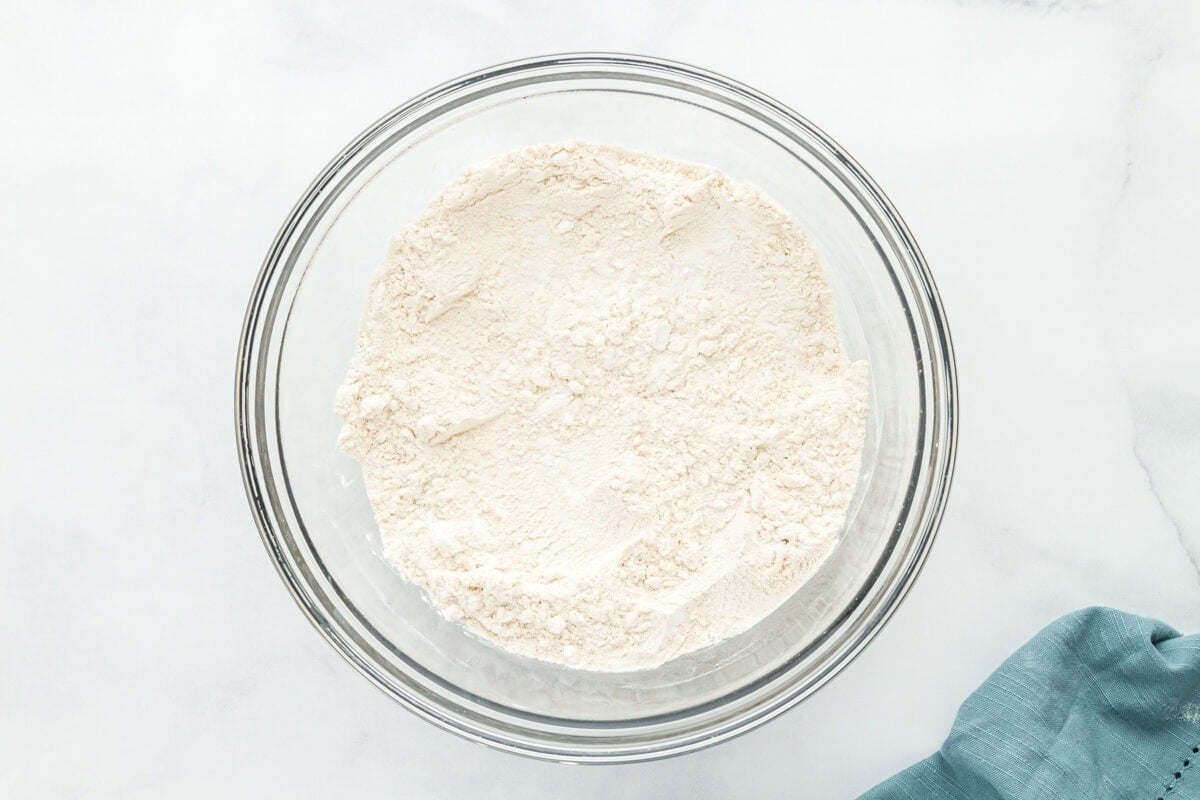
Mix the dry ingredients: In a large bowl, combine 80 grams of potato starch, 80 grams of sorghum flour, 80 grams of brown rice flour, 60 grams of tapioca flour, and 15 grams of salt. Whisk together until well combined.
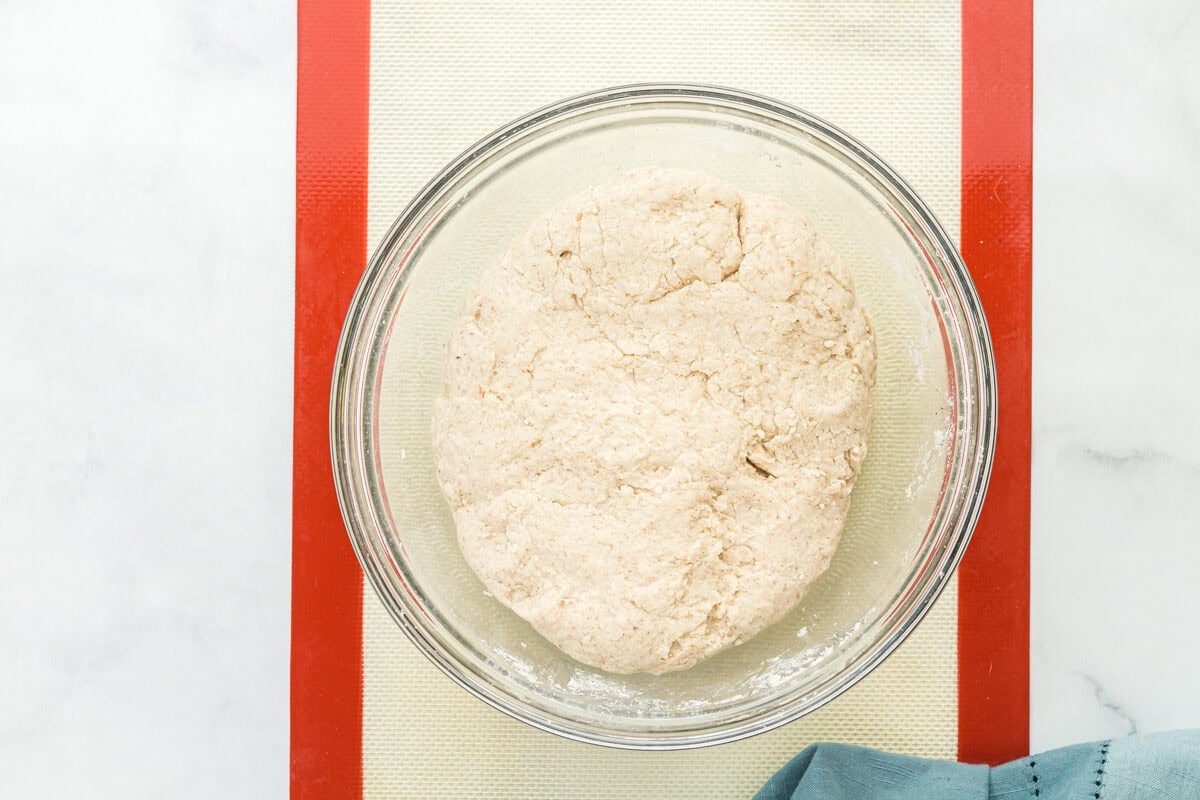
Form the dough: Add the preferment mixture and the psyllium husk mixture to the dry ingredients and mix on low-medium speed with an electric mixer and dough hook. Use a spatula to scrape down the sides and bottom of the bowl to make sure all the dry ingredients are well combined. You can use your clean hands to work this mixture as well, so that all the dry ingredients have been incorporated into the dough (the dough should feel gummy now, and you should no longer see dry ingredients).
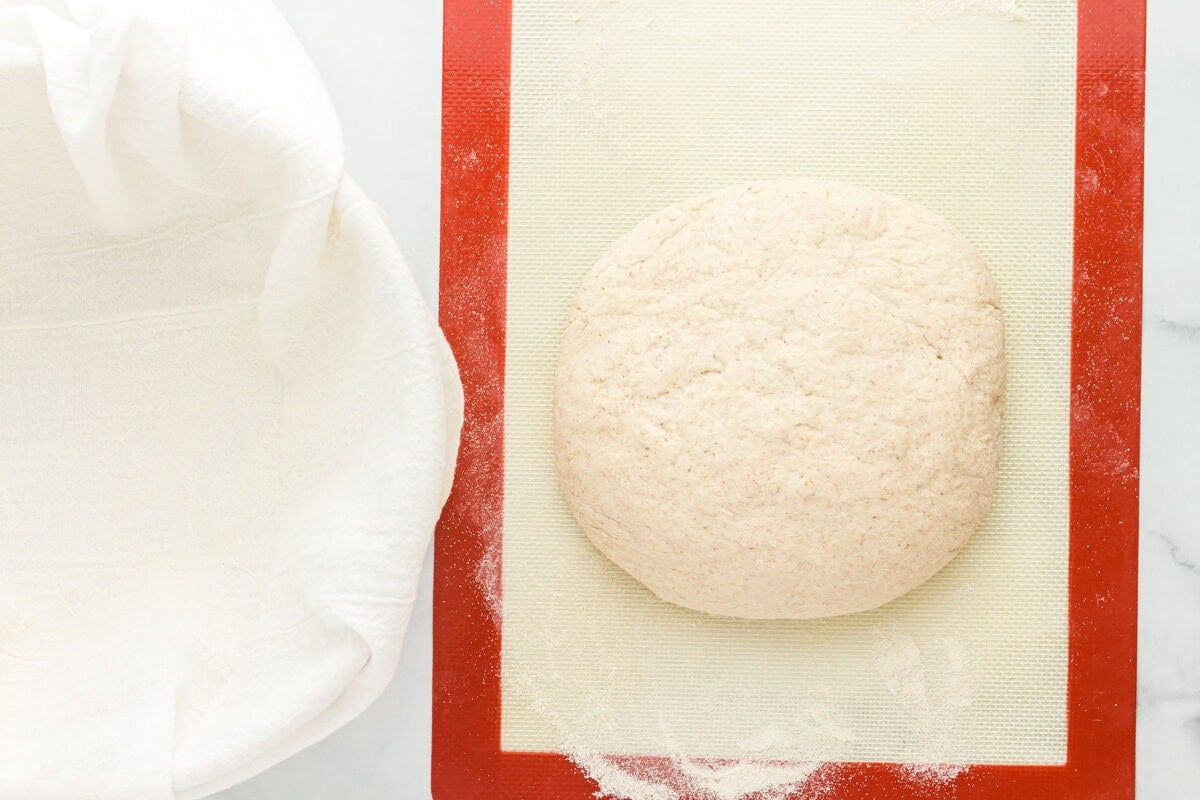
Gently knead the dough: Lightly flour (using brown rice flour) a clean, dry countertop and lightly knead the dough into a smooth ball. No stretching of the dough is needed. Simply knead the ingredients together gently until smooth. Don’t overwork the dough.
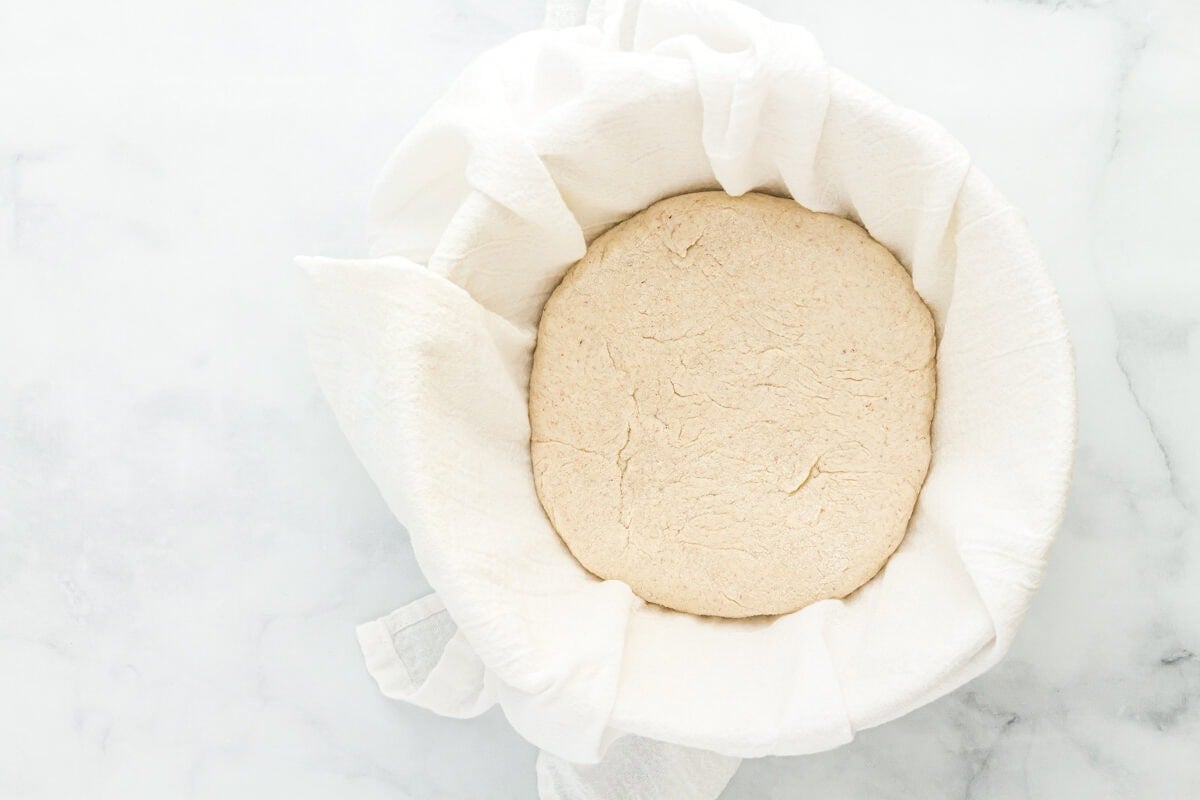
Shape and transfer the dough: Lightly flour a round, tea towel-lined bowl and place the dough ball, smooth side down, into the bowl so the seam is facing up.

Proof the dough: Lightly cover the bowl with a clean tea towel or food-safe plastic wrap and let the dough proof at room temperature for 3 to 4 hours. Depending on the temperature in your home, this could take longer, up to 6 to 8 hours. It’s ready once it has a soft, puffy texture and the dough rises back up slowly when you gently make an indent.
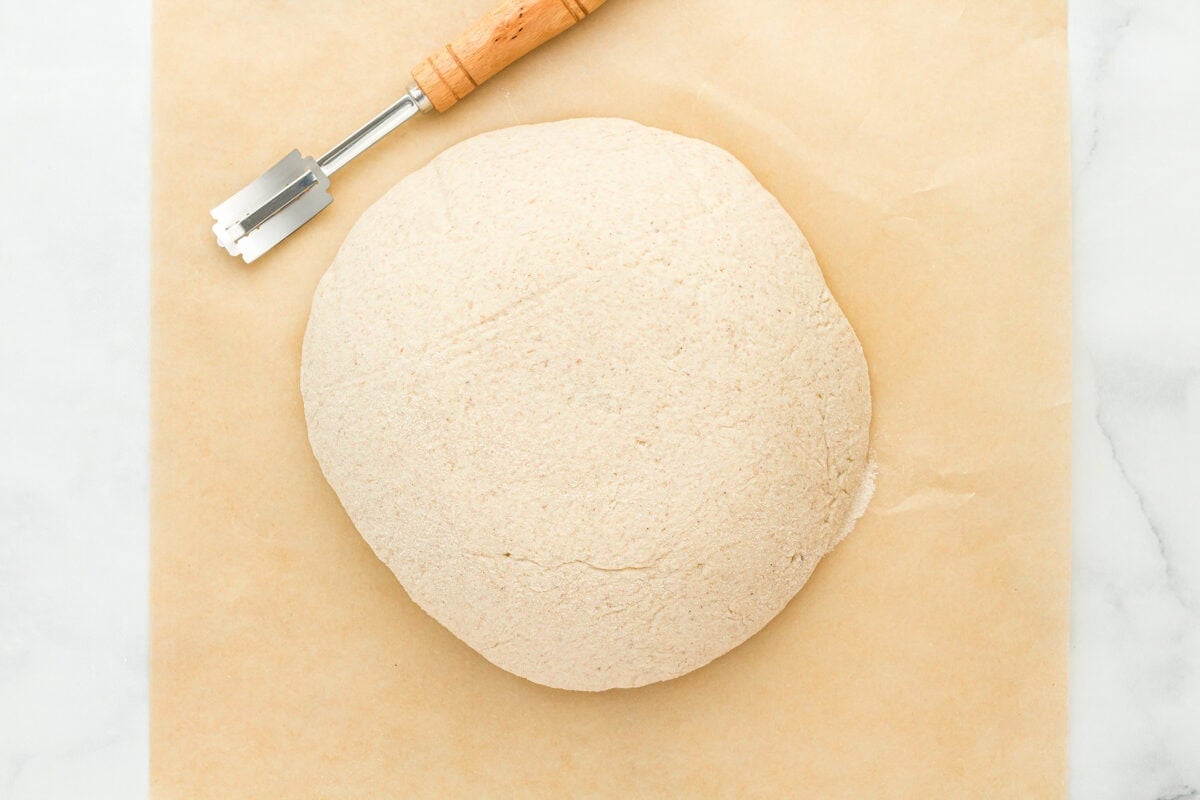
Preheat the oven and prepare the loaf: An hour before your bread is ready to bake, preheat your oven to 425°F with the Dutch oven inside. When your oven has been preheating for an hour, gently remove your proofed bread and place it on a sheet of parchment paper. Gently move this so you don’t drop it. Dropping it will limit the bread’s ability to rise properly. The loaf should now be sitting on the parchment paper, smooth side up, seams down on the parchment paper.
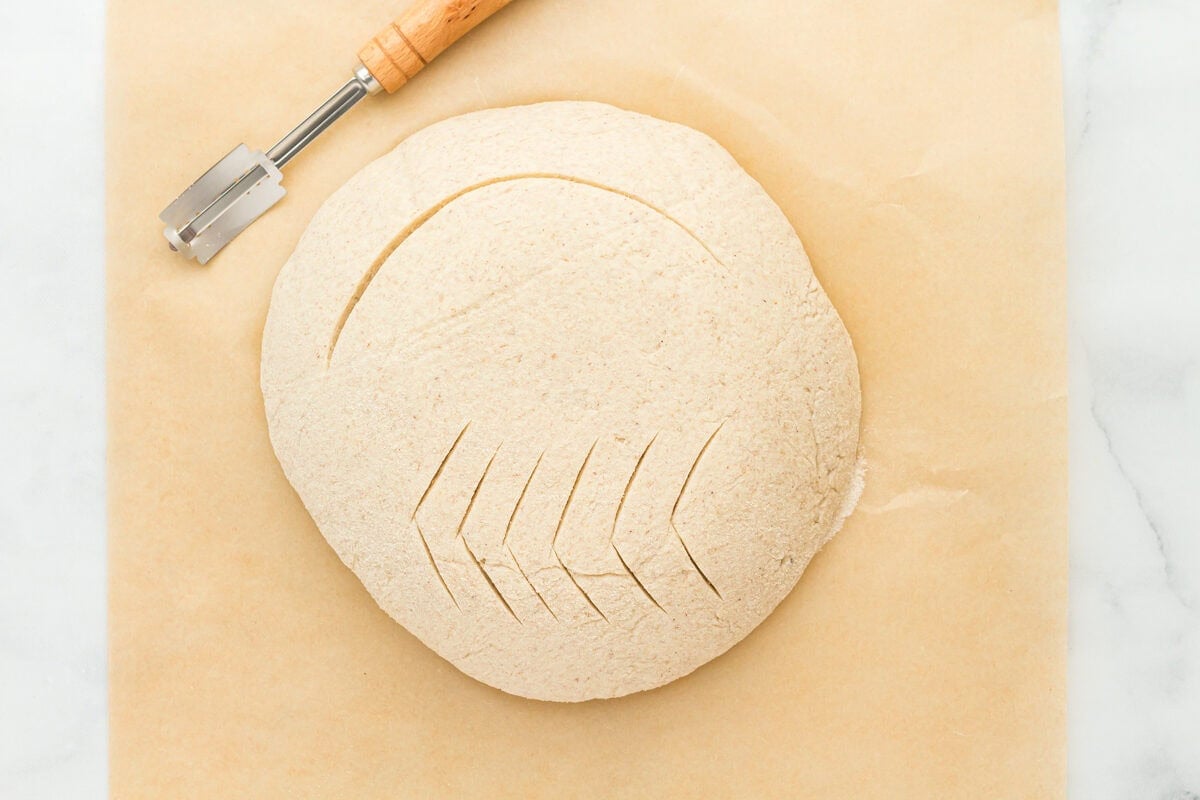
Score and add the dough to the hot Dutch oven: Use a sharp knife or a lame to cut lines into the dough to allow steam to escape while baking. Make any design you’d like, but make sure it’s deep enough (at least ¼ inch) or the bread will split in other areas. Use the parchment paper as a sling and place both the paper and bread gently inside the hot Dutch oven. Place the lid on and put the Dutch oven back into the oven. It’s important that you don’t leave the Dutch oven sitting out for long. We want this to say as hot as possible, so as soon as you remove it from the oven, place the bread in and get the Dutch oven right back into the oven.
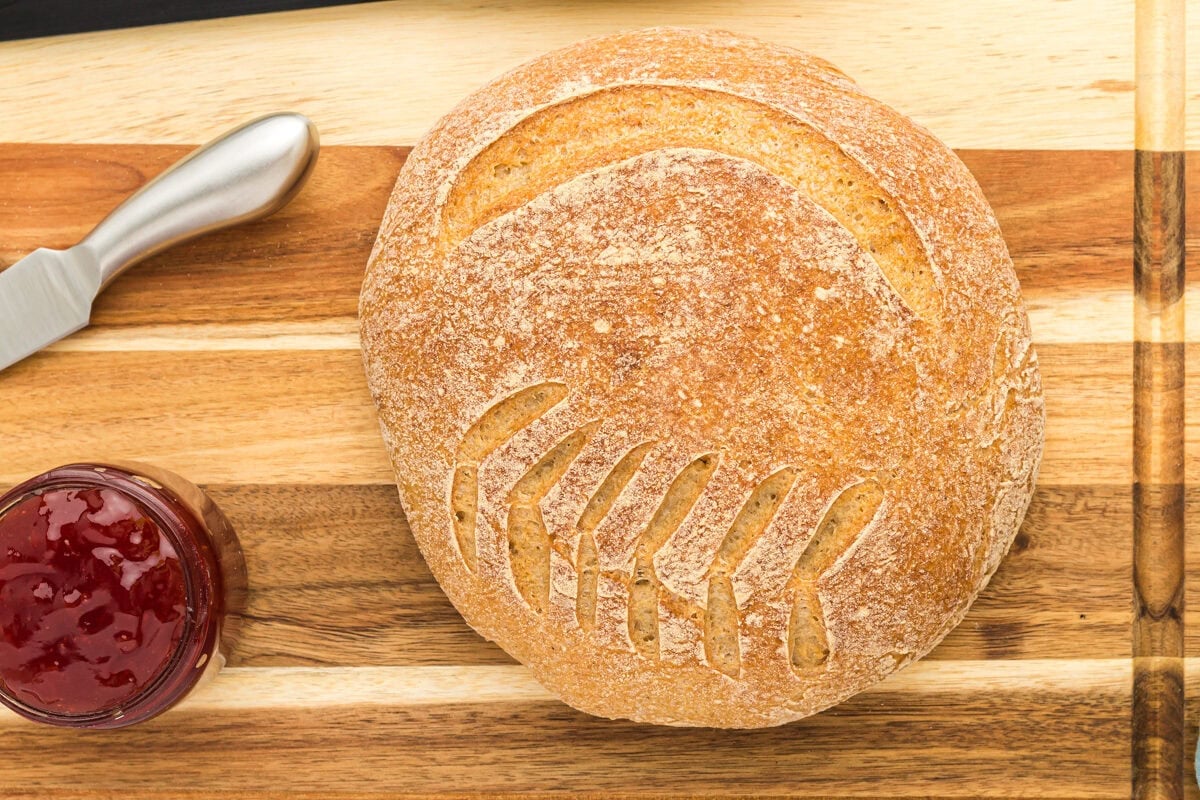
Bake and cool: Bake for 45 minutes with the lid on. Remove the lid, then bake for an additional 25 to 40 minutes. The bread is done when it is golden brown and the internal temperature is 210°F. Underbaking will result in a gummy bread. Remove the baked bread from the Dutch oven and let it cool completely at room temperature before slicing.
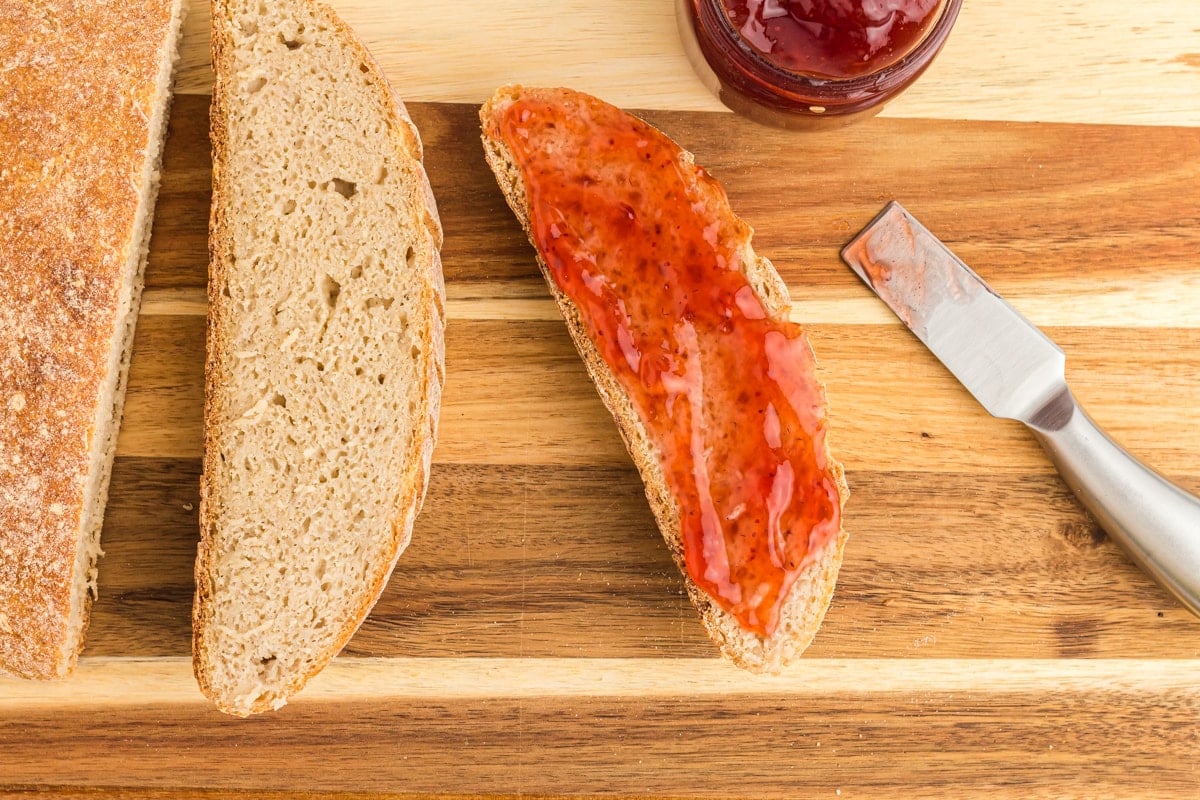
Common Questions and Mistakes to Avoid
- Getting gluten-free sourdough right takes some trial and error, especially when you’re working with a starter. One of the most common issues is using a starter that isn’t quite ready. Your gluten-free sourdough starter should be thick and paste-like, similar to Greek yogurt or thick pancake batter. If it’s too runny, try feeding it more flour and less water during the next feeding. It also needs to be active and at its peak, with lots of bubbles and nearly doubled in size. If your starter has been in the fridge, let it sit at room temperature for 24 hours and give it one or two feedings to bring it back to life.
- Many beginners try baking with a young starter, but patience pays off. While a two-week-old starter can technically be used, a mature starter that’s at least a month old will be more reliable and give you better rise and flavor.
- If you’re tempted to swap flours, be cautious. This recipe was specifically tested with superfine brown rice flour. While you can experiment with other gluten-free whole grain flours, keep in mind that each flour has a different absorbency. You’ll likely need to adjust the flour or water amounts to get the dough just right.
- Proofing is another step where things can go sideways. The longer your preferment sits, the tangier the flavor—but timing is key. Start checking your dough after about 3 hours of proofing. Overproofed dough can develop a large air pocket near the top and turn gummy at the bottom. Underproofed dough will feel heavy and lack air bubbles, leading to a dense, gummy texture as well.
- Don’t forget to preheat your oven with the Dutch oven inside. This step is crucial for helping your bread rise properly and develop a nice crust. If you want to prep ahead, you can refrigerate the dough overnight once it reaches the proofing stage—just bring it back to room temperature before baking.
- Finally, remember that gluten-free sourdough baking is part science, part intuition. Factors like weather, humidity, oven differences, and even the brands of flour you use can all impact your results. If your first loaf isn’t perfect, don’t get discouraged. Take notes, tweak your process, and try again. Each attempt brings you closer to your ideal loaf.
Why Isn’t My Dough Rising?
This could be due to too much handling. You’ll want to very lightly knead the dough just to get all the ingredients combined and to shape it. If you’re kneading too hard, you’ll knock the bubbles out. Do not knead the bread after proofing it.
A bread that isn’t rising could also be due to the starter not being ready yet. A more mature starter (a month or more) will likely give better rising results than one that’s only a couple of weeks old.
Did you proof your dough in too big a bowl? If you try to proof the dough on a flat surface or in a really large bowl, the dough is going to start to shape itself to what it is proofing in.
Why Is My Bread Gummy Inside?
This could be due to a variety of reasons. It’s important that your starter is at peak activity, that ingredients were measured properly, that the dough was properly proofed, and so on. Go back over your process to see if one of these reasons could be the problem.
Storage Instructions
Store leftover gluten-free sourdough bread tightly wrapped in plastic wrap at room temperature for up to 4 days. Freeze individual slices tightly wrapped in plastic wrap for up to 3 months. Let thaw overnight in the refrigerator before enjoying.
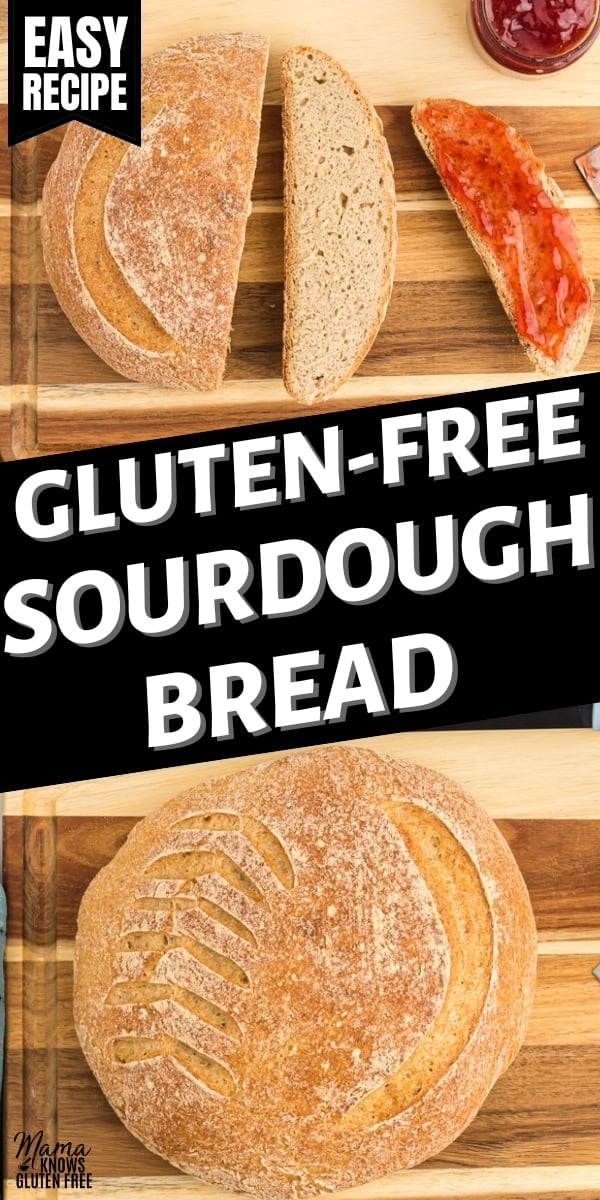
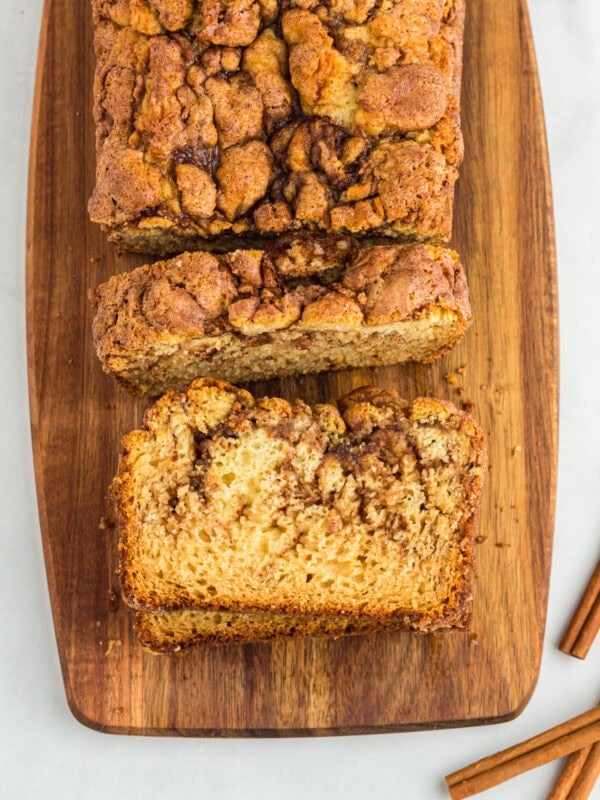
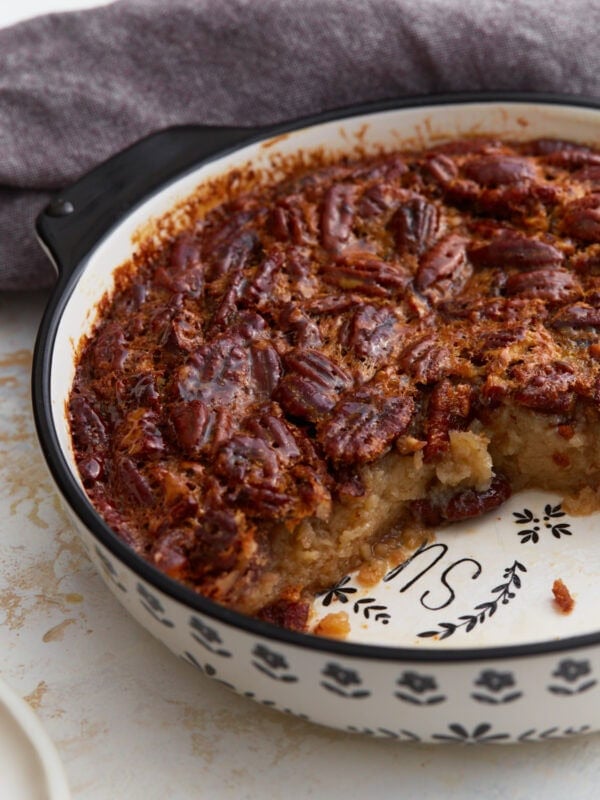








I am allergic to psyllium husk, what can i use instead?
Hi Betty, A good substitute for psyllium husk is soaking ground chia or flax seeds. For every 1 tbsp of psyllium husk- use 1 tbsp ground chia seeds mixed with 3 tbsp of water. Let it sit for 10-15 minutes to form a gel before adding it to the dough.
My house is only about 70 degrees. I have a 24 hour dough warmer with temperature setting that goes from 70-110. What range would be best to get my starter growing best this time of year. I see that it will be better to feed every 12 hours. I have only been feeding every 24 hours and using millet. I look forward to seeing the progress when I can make these changes.
I got NOW psyllium husk powder because I wanted to use less as I thought that it would be less irritating for my gut. Is there an amount of the powder that would work?
I used this too and it was very gummy. I saw on another website to use 80% powder and it was still gummy. I really liked the flavor of this bread so I tried it once more using 2/3rd the amount of powder compared to the original recipe and it turned out great!
First go at making this recipe, and any bread at all. Overall I think it came out decent but it’s gummy. My starter is over a month old; however while it rises it never seems to truly double. The dough rose when proofing but seemed as it could have proofed more but didn’t. I checked the temperature after baking and got a temp of 212, but the thermometer came out gummy but I was nervous to over cook the loaf. I waited until it cooled to about 74 degrees before slicing. Any helpful hits to try and get a loaf that’s not as gummy? TIA <3
Hi Alicia, If your starter never doubles, it’s likely underfed or not active enough. Try feeding it twice a day for a few days in a warm spot (75–80°F) and using it at peak rise. Next time, try baking it an extra 5-10 minutes, then turn off the oven, open the door slightly, and let the loaf sit inside for 10–15 min to help dry it out. Wait 2-3 hours to slice the bread!
I’m so glad I can make homemade bread that accommodates our food allergies. Thank you for this recipe, it’s delicious! I always proof my bread in the fridge overnight. I’ve made several loaves and they have all turned out beautifully. My family is asking for loaves with additions: rosemary olive oil, cinnamon swirl, or chocolate chip. How do you handle additions with this recipe? Thank you!
Hi Stephanie, such a great idea to add mix-ins! Here’s how I’d do it:
Rosemary & olive oil: Add chopped rosemary and olive oil when mixing flour and oil/water step, so the flavor infuses evenly.
Cinnamon swirl: After the dough is shaped or in a loaf pan, swirl in cinnamon-sugar mixture before proofing or baking.
Chocolate chips: Fold into the final shaped loaf or swirled mid-shape to ensure distribution without interfering with the rise.
This bread recipe is fantastic. I am wondering: is it possible to bake it in a loaf pan? Or to somehow change the shape a bit have it be better for sandwiches? Thanks!
Yes, you can bake it in a loaf pan—and it’s a great idea if you want a shape better suited for sandwiches! After the bulk fermentation, instead of shaping it into a boule, gently press the dough into a loaf shape and place it directly into the pan.
Can preferment be left on the counter overnight? Also after removing the starter needed for the recipe should the starter be returned to the fridge ?
Hi Dori, you can leave the preferment out on the counter overnight—anywhere from 8 to 18 hours is typical, depending on room temperature (warmer kitchens will speed up fermentation). After removing the portion of starter needed for the recipe, you should feed the remaining starter, let it sit at room temperature for a few hours to rise and bubble, then return it to the fridge for storage until the next use.
Thank you for this recipe!! Finally a GF bread recipe that works and tastes great!
I’ve found that using a covered, long baking clay helps the dough rise and makes for better sandwich slices. Now let’s get fancy – do yo have a GF rye bread recipe?
Glad you liked it! We don’t have a rye bread recipe currently.
Do you have a substitute for potato starch?Along with gluten, I am extremely allegeric to potatoes. Unfortunately, almost any pre-made GF bread also have potato starch or flour in it. My main reason for baking my own. I am also finding this with many receipes? Could you use cassava?
Hi Amanda, arrowroot powder, cornstarch, or tapioca starch are used as a substitution sometimes.
After making my starter and nurturing it for two weeks, I made the preferment last night in preparation for trying my hand at baking today. When I woke this morning, my preferment had risen well overnight, but fallen significantly.
What do I do now? Should I throw it out and start over, feed it again and wait or use it and hope for the best?
This is a good sign! The fact that it fell just means it likely reached its peak fermentation and exhausted its food supply. Give it a quick stir and you’re ready to bake.
I am brand new at making sourdough bread much less gluten-free sourdough bread.
From my very first loaf, it turned out fantastic. Loaf after loaf it continues to be excellent. So grateful I found this recipe.
Every person who taste it raves about it, and in my opinion, it has no trace of tasting like gluten-free. As gluten-free people we had pretty much given up on ever eating any good bread again. This has changed everything.
The only gluten free bread I’ve had that makes me want to eat it! I’m wanting to try sweet inclusions though and this recipe is too salty to support them. What are your suggestions for a sweet loaf?
Can this bread be frozen prior to baking? And if so, could you tell me how. I want to make a few loaves but only bake them as needed. Thank you!
Hi Katy, we recommend baking the loaves, then slicing and freezing them. You can toast individual slices to bring them back to just-baked freshness.
Please help me. I worked on my gluten free starter for just over a week. It was nicely doubling in size so I did the 24 hr feed. It also doubled so I decided to move on to trying to make a loaf. Maybe my mistake was feeding it to make TWO loaves? It rose about half as much as before. I’m leaving it overnight but if it doesn’t double do I discard and try again?
What Psyllium do you use
Hi Jacob, we recommend “Now” brand or “Anthony’s”!
Hello Audrey,
Is there any substitute for the psyllium seed in this recipe, any other seed option? In the past this really has not agree with my digestive system. Now that I’ve been GF for more than a decade, maybe it will not be, but a little leery of it still. Thanks!
Hi Marguerite, unfortunately, we have not tested this recipe with a substitute for psyllium husk. You could try chia or flax seeds, but we cannot guarantee the results.
starting this recipe it says to add an active starter. does this starter need to be at peak rise after three last feeding?
Soooo good!! Before I found this recipe, I used to make a different one and it was okay, then I made this and realized this one is SO much better!! I followed the recipe pretty closely but I have a starter made with Bobs 1:1 (it didn’t work very well with just brown rice). I am at high altitude so I have to bake the bread almost 20 extra min to have it done in the middle. I’ve made it twice and I’m going to do a third starting tonight! Thanks!!
Why do use psyllium husk instead of psyllium husk powder?
Hi Hayley, It behaves differently when used to bind a gluten-free dough 🙂
Is there is substitute for sorghum ?? I can’t find it anywhere???
Hi Madison, millet flour is your best bet!
Any ideas on what I could use instead of tapioca flour? Tapioca of any sort is a major trigger for me. GF baking seems to rely on tapioca.
Hi Emmie! I would suggest looking into making your own blend of GF flour excluding tapioca. You could try a blend of flours like white rice flour, potato flour, and corn flour.